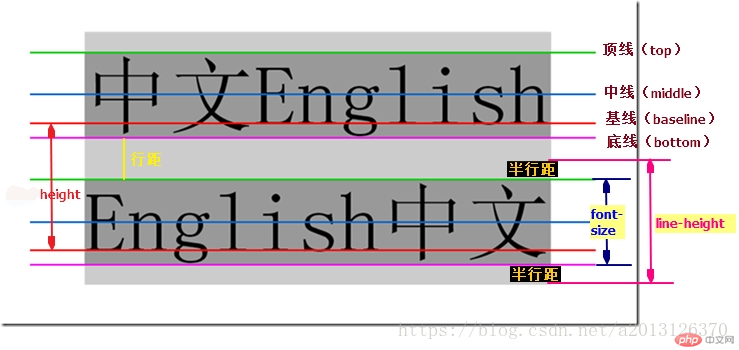


相信页面元素居中是大家常用的需要,那么你有研究过怎么居中吗,首先我们要知道页面页面居中几个基础概念。
- 容器: 其实它是Html中元素,不过只有块级元素和行内块元素才可当容器。
- 元素: 就是要居中的对象,可以是行内元素、行内块元素和块级元素。
- 元素类型 W3C定义了常用元素的类型,我们也可以通过display重新定义它的类型 ,如a链接元素默认是行内元素,可以定义它为行内块元素或块级元素。目前浮动float、定位position、table盒子(是display:table,而不是table元素)、flex盒子和grid盒子都默认将子元素转化为行内块元素 ,不论它之前是行内元素还是块级元素。
- img元素 为什么单独提它,是因为百度时有人说它是行内块元素 ,因为它可以设置宽度和高度,有人说它是行内元素 ,因为在样式中显示inline(通过chrome开发者工具的Styles),那么到底它是什么类型?通过我实际测试,它呈现出来的是行内块元素特性 。虽然chrome开发者工具Styles显示它是inline行内元素,开始居中时就受它的误导。正如盒模型box-sizing:content-box一样,W3C开始定义的不被设计所接受,反而微软IE盒子(box-sizing:border-box)被大众所接受一样,它可能还要重新定义。
在说居中之前,我们必须弄清height和line-height二者区别,才有更好理解行内元素和行内块元素剧中的实现。

行高是指文本行基线间的垂直距离 , 基线(base line)并不是汉字文字的下端沿,而是英文字母“x”的下端沿。上图中两条红线之间的距离就是行高Height ,上行的底线和下一行顶线之间的距离就是行距,而同一行顶线和底线之间的距离是font-size的大小 ,行距的一半是半行距。下面演示了font-size、height和line-height的关系
<style>.test {margin-bottom: 30px;text-align: center;border: 1px solid black;background: red;}.test1 {line-height: 0;}.test2 {line-height: 30px;}.test3 {height: 30px;line-height: 30px;}.test4 {height: 50px;line-height: 30px;}.test5 {height: 10px;line-height: 30px;}.test6{font-size: 50px;line-height: 30px;}.test7{font-size: 50px;height: 30px;}</style><div class="test test1">line-height为0</div><div class="test test2">只设置line-height,没设置height,则height取line-height</div><div class="test test3">line-height和height相等时</div><div class="test test4">line-height小于height时</div><div class="test test5">line-height大于height时</div><div class="test test6">font-size大于line-height时</div><div class="test test7">font-size大于height时</div>

高度和行高总结:
- line-height是透明的 ,它决定内容垂直对齐方式,默认是baseline。
- height是受背景色影响的
- 垂直居中 其实vertical-align等于middle就居中了,而我们平常所说的垂直居中是视觉居中 。就是height和line-height相等时,它们区域重叠,此时垂直居中就在视觉上也居中了。
特别说明: line-height是继承属性,就时说它会继承父元素的line-height 。
有了上面基础认识后,再说行内元素和行内块元素居中就好理解多了。行内元素和行内块元素居中涉及三个属性:text-align、line-height和vertical-align。下面是我总结的
- 水平居中: 无论是行内元素或行内块元素,水平居中只要 容器(父元素) 的text-align:center就可以了。
- 垂直居中: 分为行内元素和行内块元素
- 行内元素垂直居中:容器(父元素)的line-height等于其的高度height就实现垂直居中。
- 行内块元素垂直居中:①同行内元素垂直居中,将容器line-height等于其height②行内块元素设置vertical-align:middle就实现了垂直居中。
<style>* {margin: 0;padding: 0;border: none;outline: none;box-sizing: border-box;}.container {width: 100vw;height: 100vh;color: #333;}.box {margin-bottom: 2em;}/* 行内元素水平居中和垂直居中 */.box p {background-color: cadetblue;height: 10em;text-align: center;line-height: 10em;}.box .in-block {width: 50vw;}/* 图片垂直居中 */img {vertical-align: middle;}</style><div class="container"><div class="box"><p class=""><span>页面元素居中方法探讨</span></p></div><div class="box"><p class="in-block"><span>页面元素居中方法探讨</span></p></div><div class="box"><p class=""><img src="banner_img.jpg" alt="" height="70%" /></p></div><div class="box"><p class="in-block"><img src="banner_img.jpg" alt="" height="70%" /></p></div></div>

块级元素水平居中一般是margin:auto闵可以了,垂直居中先介绍下定位实现的垂直居中,详细分析见我的博文https://www.php.cn/blog/detail/24594.html
* {margin: 0;padding: 0;}.wrapper {display: flex;justify-content: space-around;margin-top: 50px;margin-bottom: 100px;}/* 一、父元素未指定高度 */.container {background-color: lightgray;position: relative;}/* 二、父元素指定高度 */.con-fixed{width:40vw;height: 30vh;}/* 1.元素未指明宽和高,即都是width:auto;height:auto; */.box {position: absolute;left: 0;top: 0;right: 0;bottom: 0;}/* 2.元素指明宽度 */.box-fixed {width:20vw;height: 10vh;}/* margin百分比和auto */.auto {background-color: #007d20;opacity: 0.9;margin: auto;}.per {background-color: lightsalmon;opacity: 0.9;margin: 5%;}</style><div class="wrapper"><div class="container"><h1>未指明父元素宽度和高度</h1><h1>未指明父元素宽度和高度</h1><div class="box auto">未指明元素宽高,即都为auto,margin也是auto</div><div class="box per">未指明元素宽高,即都为auto,margin是百分比</div></div><div class="container"><h1>未指明父元素宽度和高度</h1><h1>未指明父元素宽度和高度</h1><div class="box box-fixed auto">元素宽度为20vw,高度为10vh,margin是auto</div><div class="box box-fixed per">元素宽度为20vw,高度为10vh,margin是百分比</div></div></div><div class="wrapper"><div class="container con-fixed"><h1>父元素宽度为40vw,高度为30vh</h1><h1>父元素宽度为40vw,高度为30vh</h1><div class="box auto">未指明元素宽高,即都为auto,margin也是auto</div><div class="box per">未指明元素宽高,即都为auto,margin是百分比</div></div><div class="container con-fixed"><h1>父元素宽度为40vw,高度为30vh</h1><h1>父元素宽度为40vw,高度为30vh</h1><div class="box box-fixed auto">元素宽度为20vw,高度为10vh,margin是auto</div><div class="box box-fixed per">元素宽度为20vw,高度为10vh,margin是百分比</div></div></div>

正如开始所说table盒子、flex盒子和grid盒子将子元素转化为行内块元素,但它们的居中了除了table盒子外建议不要使用vertical-align,我也没测试,因为它们本身居中属性。
flex居中看我的博文https://www.php.cn/blog/detail/24616.html
grid居中目前还没写,可以关注我的博客
再推荐一篇我写的博文《盒模型中的百分比和auto探讨及居中的应用》https://www.php.cn/blog/detail/24594.html ,其中探讨了单位,也探讨了部分居中问题。
写了这么多方法,相信你和我一样有点模糊,什么时候用那个要怎么介定,其实这个问题是在我去饭堂路上的想到的,这里说下我的总结:
居中方式: 分为普通文档流居中和非普通文档流居中
- 普通文档流居中: 使用普通文档流中对齐属性 ,常见如text-align、line-height、vertical-align和margin。
- 非普通文档流居中: 当元素脱离普通文档流后,再单独使用上面对齐属性就达不到居中效果了,此时需要结合转变成非普通文档流的方式的相应属性,如定位中left、top等、flex和grid的对齐属性。
几个特例:
- 块级元素 块级元素是普通文档流中元素,水平居中可以使用普通文档流方式margin,而垂直居中可以普通文档流的对齐属性如margin和padding,但这种方法只适用比较固定情况下,而动态时实现计算比较困难。此时我们一般将它转换为非普通文档流进行居中 。
- img元素 它是比较特殊的元素,虽然上面我讲尽管W3C定义它为行内元素,但它要按行内块元素方式居中 。
- 行内块元素和BFC 至于BFC(块格式化上下文)的探讨见https://www.php.cn/blog/detail/24616.html,记得我文章开头说行内块元素可以使用普通文档流对齐属性,而flex、grid、float、position都是将普通元素转换成BFC ,但它 不是普通文档流中行内块元素 ,它是 “独立王国”的行内块元素 ,它不属于普通文档流,所以要使用它们自己的属性来居中。
到这里页面元素居中探讨就基本结束了,加上我的博文《盒模型中的百分比和auto探讨及居中的应用》https://www.php.cn/blog/detail/24594.html 应该可以解决大多数居中问题,其它居中实现可以参考上面思路实现。